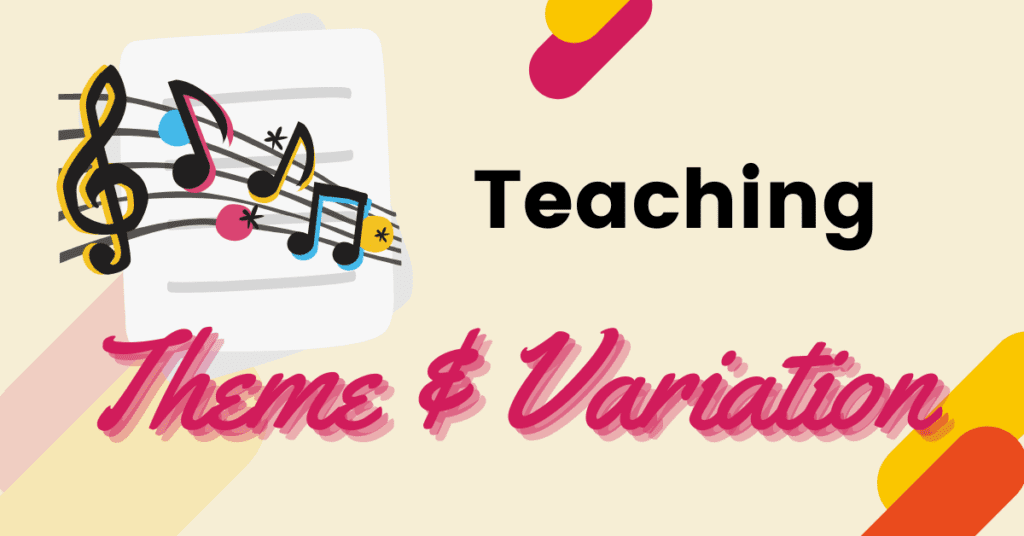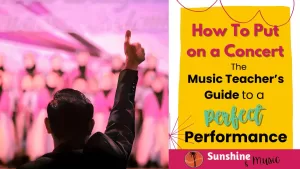So for as long as I can remember, I have been teaching a unit on theme and variation with my 4th graders. We define the form a by the end of the unit, they have to create a variation on Hot Cross Buns. I have to say that every year, my kids had struggled so much with the concept and I just did not understand why.
Each year, I tried to break it down into more and more manageable steps, but still made little headway. But this year I finally had a break through! The kids were effortlessly creating variations (hallelujah!). So I thought I would share my breakthrough with you guys, in case you might want to use a project in your class as well.
The Introduction
I start by doing a quick introduction into what a theme and variations are. I show them and example of theme and variation in art (Andy Warhol’s Campbells Soup pictures), and math (translating a shape on a grid) and finally music. Then we learn about how we can change the form, the pitch order or the rhythm of Hot Cross Buns, but keep other elements the same and create a variation.
Real Example
Next we listened to Variations on a Shaker Melody (from Copland’s Appalachian Springs) and do a little worksheet about what we hear in each variation.
Form Variation with Partners
This part was the game changer for me. In past years, I did some examples at the board for the class and then had them work by themselves. I’m telling you, any time you can have kids work in groups instead of lecturing from the board, they are going to learn so much more. (Sometimes I really must sound like that teacher in Charlie Brown – wah wah wah). Here’s what I had the students do:

- Each group got an envelope with form cards and note pattern cards.
- Student had to choose a form that was different from the theme (Hot Cross Buns – AABA). We reviewed how musical forms always start with A.
- Student got to pick which note pattern would be part A and which would be part B.
- Students played their song and then made decisions about editing it until they had created a version that they liked.
- Students shared their variation for the class by playing it on the recorder.
- Bonus question: I made the students choose a form different from AABA. However, there is one way to keep the form AABA and still be a variation. What is it? ANSWER: Make the “one a penny, two a penny” part A and the “hot cross buns” part B.
Rhythm Variation with a Partner
I pass out laminated staffs and dry erase markers. Students then have to decide on what rhythm they will have on beat one (B), beat two (A) and beats three and four (G). This one was still a little hit and miss with this group, so I would probably schedule a review of writing BAG on the staff and practice writing different rhythms on B, then A then G first before proceeding next year.
But if you are a rockstar and have your kids writing on the staff all the time, you will probably not have this issue. For mine, I was surprised because they can read BAG, but writing it was a struggle (not for most of them but maybe 25%). But I do have a lot of new students in fourth grade this year so that may be part of it too.
Time to Fly Solo
Now that the students have had the chance to work in the safety of a partner group on creating a variation using form or rhythm, I give them a worksheet and they create a variation all by themselves. This picture shows an old version of the worksheet I use, but you get the idea.

I think that having some activities where the students work with a partner to create a form allows them to experiment without the feeling of pressure for a grade and with the support of a buddy or two. This can build their confidence going into the individual assignment, which is certainly what I saw in my classroom after doing these activities. Maybe I’ll even make some cool kits this summer to pop up on TeachersPayTeachers if you are looking to not have to do the ground work for the groups. Keep and eye out!
Related Blog Posts
Finding Joy and Beauty With the Music of Aaron Copland in Elementary Music








2 Responses